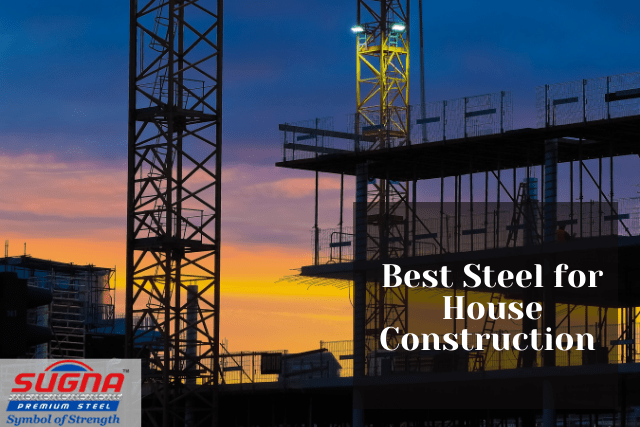Which steel is best for House Construction?
TMT Steel is the best steel for house construction. Thermo Mechanically Treated steel bars are made from high-quality low, carbon structural steel. When the steel has been heated and mechanically treated, it becomes solid and durable in different applications.
This process creates a surface that is corrosion-resistant, fire-resistant, and malleable, which means it can stretch without breaking under stress or pressure. TMT Steel is highly resistant to radiation, and its products show a minimal loss in strength after prolonged exposure to gamma-radiation.
In addition, TMT Steel can be readily welded, riveted, bolted, or tied to properties required by the construction design.TMT also has excellent soundproofing properties.
The damping effect of TMT steel on sound is excellent, especially when compared to concrete and clay bricks. TMT steel’s temperature is low during construction, so the worksite is not very hot and noisy, unlike other building materials.
TMT steel has excellent thermal conductivity, which means it can be quickly joined together and welded without problems. It is resistant to overheating and dehydration in high temperatures. The easy-to-forge properties of TMT Steel mean that casting girders and structures is very easy.

Why is TMT Preferred for house construction?
Here are some reasons why TMT steel for house construction is preferred over Non-TMT -steels
Fire-resistant:
Ordinary steel has a low fire resistance capacity and can only resist heat till a particular time. At the same time, TMT bars are fire resistant as long as there’s nothing explosive in the structure.
Generally, when non-TMT steels are heated up to 1800 degrees Celsius, their fire resistance will significantly decrease. Also, if they are heated even further beyond that point, they will lose their strengths completely.
However, TMT steel is highly fire-resistant and these properties won’t be altered by reinforcement, unlike other steel that gets weaker when heated up or becomes brittle when exposed to fire.
Also, due to its very high yield strength and tensile strength, TMT steel can be easily twisted into different shapes without breaking. When TMT steel is exposed to fire, the metal will not melt but rather char and form a protective layer of iron oxide.
Ductile
The amount of carbon in steel decides its ductility. Non- TMT steels generally have very high carbon content, which increases its strength, but reduces elasticity.
Therefore, they do not make excellent building materials. In contrast, TMT steel has a very low carbon content. Therefore, TMT Steel is ductile and easily twisted into different shapes without breaking.
It helps create structures that are not only excellent in terms of strength but also flexible and resistant to corrosion. TMT steel can be easily bent to different shapes without affecting its structure or strength.
With bolting, the material can be easily aligned into various forms without disturbing its power, and thus, any stability problems will not occur.
It can be drawn into a wire, making it an excellent choice for wiring buildings due to its strength and capacity to conduct electricity without breaking down over time as other wires would do in that environment.
Strength
Mild steel has a very low carbon content, which makes it quite less strong. Even Though, TMT steels have low carbon content, the tensile strength of TMT is 64000. TMT Steel is very durable, especially at high temperatures. It can be called practically indestructible.
It is easy to cast into different shapes by hammering them into the desired shape. The material does not break easily and can be quickly joined together with bolts and nuts, unlike other steel, which requires welding at specific points depending on the complexity of the structure being built.
The high tensile strength property of the TMT bar is particularly beneficial for construction with curved shapes as it does not require welding at the points where the girders are connected, unlike other non-TMT steel which need welding at specific points
Efficient and economical
Non-TMT steels are hard and heavy, and therefore, the cost of transportation increases. However, TMT Steel is a very energy-efficient material as it hardly needs any energy for its production or the transportation of it to the construction site. The material costs less than other materials on production, transport, and building & maintenance costs, resulting in significant savings in the overall budget.
Corrosion
Steel is an alloy of iron and therefore is prone to corrosion. As a result, they need painting very often for corrosion resistance. However, TMT Steel is highly resistant to corrosion from acidic chemicals that cause structural damage. The chromium content helps the metal to resist corrosion from sources like salt air and humidity.
Conclusion
TMT steel is primarily used in industrial buildings and tall buildings due to its strength and conductivity, making it an excellent choice for daily life habitation. If you are looking for good quality TMT steel then hire experts from Sugna TMT Bars.

